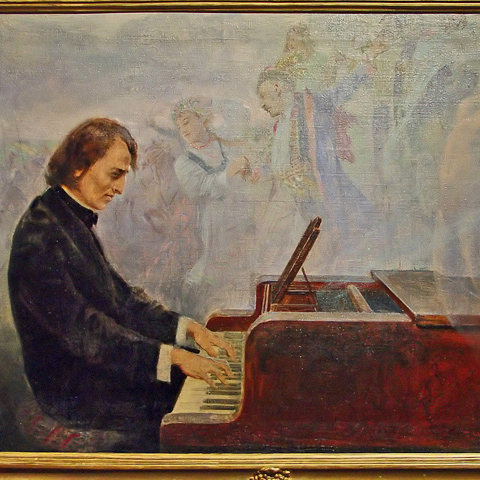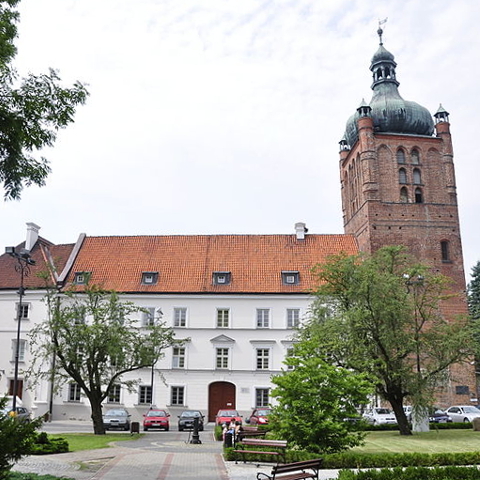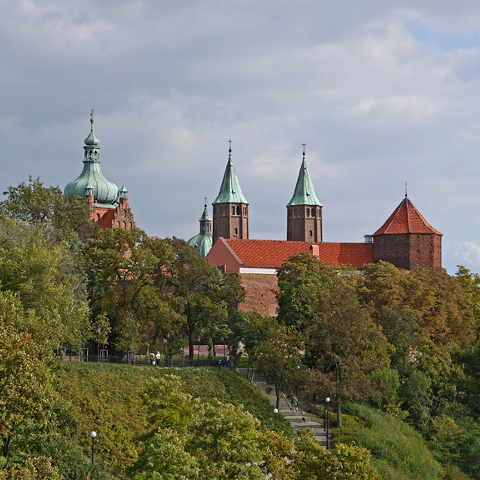Composers / Fryderyk Chopin / Places catalog
Płock
The history of Płock is closely bound with that of Poland. The city acquired special significance in the latter half of the eleventh century, when it was made the seat of the newly established Diocese of Mazovia (1075) and the capital of Poland, during the reigns of Ladislaus I Herman (1079–1102) and Boleslaus III the Wry-mouth (1107–1138). When the last Duke of Mazovia, Janusz II, died childless, in 1495, Płock was annexed by Poland and made a voivodeship capital.
Chopin stayed on the Zboińskis’ estate in Kowalewo, Płock County, during his 1827 summer holiday. In a letter to his family in Warsaw dated 6 July 1827, he refers to a trip to Gdańsk and mentions Płock, barely 30 km away, as the first stop: ‘Since my health serves me like some sort of trained dog, [and Mr] Zboiński’s little yellow eyes are downcast as we set off for Płock, it would be madness if, for my part, I were not to report about this. And so, today in Płock […]’.
Płock was not on the planned route to Pomerania, but given the city’s rich and fascinating history, Count Ksawery Zboiński most likely wanted to show Chopin around. It is worth mentioning that Ignacy and Franciszek Zboiński served as castellans in Płock during the eighteenth century.
Chopin was expecting a letter from his parents and voiced his impatience in this surviving letter, written while still in Kowalewo: ‘today in Płock I will turn the entire post upside down, if only something would be there for me’. This letter, which after suitable folding served as its own envelope, bears the postmark ‘Płock 8 IULII’. The Płock post office was then located at ul. Warszawska 274 (now ul. Kościuszki 13).
The precise details of Chopin’s stay are not known. We can only hazard a guess at which of the city’s many historical buildings he might have seen or visited. He almost certainly would have visited the beautiful old town and the recently built neoclassical town hall designed by Jakub Kubicki. (It is worth pointing out that the layout of Plac Zamkowy and the thorough reconstruction of the Belvedere, both in Warsaw, were the work of Kubicki.)
Chopin would definitely have visited St Bartholomew’s church, near the town hall. This was founded by Casimir III the Great (1333–1370) and is the oldest parish church in Płock, although it was rebuilt in the Baroque style during the eighteenth century. Zboiński would not have left the famous Płock Cathedral off the itinerary. One of Poland’s most valuable architectural jewels, it was built on Wzgórze Tumskie [Cathedral hill] in 1130–1144, at the behest of Bp Alexander of Malonne (now in Belgium). Inside the cathedral is the Royal Chapel, where, two years earlier (1825), Ladislaus I Herman and Boleslaus III the Wry-mouth were entombed in a black marble sarcophagus specially designed by Zygmunt Vogel.
The Dukes of Mazovia had their seat in Płock Castle, which was built on the site of the seat of Ladislaus I Herman and Boleslaus I the Valiant on the initiative of Casimir III the Great. The important parts of the castle, which are still there, were the noble tower (rectangular at the bottom and octagonal at the top) and the clock tower. The castle was the seat of the dukes until the end of the fifteenth century. It was transferred to the Benedictines somewhere around the middle of the sixteenth century. The castle and the Benedictine abbey now house the Diocesan Museum, the abundant collection of which includes valuable works of sacred art and extremely rare antique manuscripts, including the beautifully illuminated twelfth-century Płock Bible. The collection also boasts the piano that was used in the Aleksander Ford film Youth of Chopin (1951). The municipal museum has its share of Chopinalia, too. There is a bronze cast of the composer (on a scale of 1:8), made in 1922 according to Wacław Szymanowski’s famous design for the Chopin monument in Łazienki Park, Warsaw, and a 1910 oil painting of Chopin at the piano by Feliks Michał Wygrzywalski.
The town hall and the old town marketplace have recently been redeveloped. The town hall has been the seat of the city authorities ever since it was built.
In 2008, the city council amended the Municipal Statute of Płock to change its official name to ‘The Ducal Capital City of Płock’.
-

Cathedral in Płock. Phot. Krzysztof & Maria Różański. (creative commons)
-

‘Chopins Concert’, Feliks Michał Wygrzywalski. Masovian Museum.
-

Płock Castle. (creative commons)
-
.jpg)
Tumskie Hill, Adolf Kozarski in: ”Tygodnik Ilustrowany”, 1863, No. 179, p. 81.
-

Tumskie Hill. (creative commons)